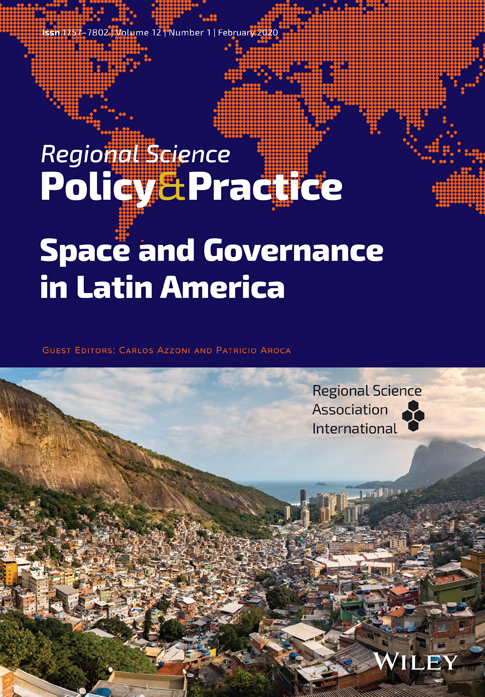
The latest issue of Regional Science Policy & Practice
Volume 12, Issue 1, Special Issue: Space and Governance in Latin America, Pages 1-225, February 2020
Issue Edited by: Carlos Azzoni, Patricio Aroca
Introduction
This special issue of Regional Science Policy & Practice is devoted to Latin American issues and includes papers presented at the 1st Congress of LARSA–Latin American and Caribbean Regional Science Association, which took place in Sao Paulo, Brazil, at the Universidade de São Paulo, on 11–13 October 2017. It also includes other papers by members of LARSA dealing with topics involving countries of the region. The first congress was organized by the Brazilian section of RSAI, the Brazilian Association of Regional Studies (ABER—Associação Brasileira de Estudos Regionais) and that explains the predominance of papers dealing with Brazilian issues. After that first congress, other conferences happened in San Pedro de Atacama, Chile, in 2018, and at Mexico City, in 2019. LARSA includes the national associations of all countries in the region. As Latin America is diversified in its regional aspects, with many countries presenting high levels of regional concentration and inequality, this issue covers many dimensions of regional problems and offer a broad perspective of the space‐related problems in the region.
Latin America traditionally exhibits a strong presence of the public sector, in many dimensions. Thus, the first three papers deal with different forms of government intervention. The analysis of Bonet‐Morón and Ayala‐Garcia deals with the estimation of the expenditure needs and fiscal capacity of Colombian municipalities and departments. They estimate the spending needs of each spatial unity, and use data envelopment analysis for the local fiscal capacity. Their results indicate that an equalization transfers system could be established to solve the observed fiscal disparities in the country. The study by Serra and Antunes deals with an interesting situation, which is the earmarking of tax revenues to particular programmes. This strategy is quite attractive, for it facilitates the approval of a new tax, or the increase of existing ones. It was popular in Brazil, but the country’s Supreme Court ruled it unconstitutional, which created a perfect case of an exogenous experiment. The authors identify the impact of the court’s decision on housing deficit with a difference‐in‐difference model with probit estimators. As was common in the past, and even nowadays, most countries present some form of preference treatment for their lagging regions. The paper by Ribeiro et al. applies a dynamic interregional computable general equilibrium model to isolate, through simulations, the effects of funding provided at favourable conditions to entrepreneurs on the regional inequality within states in the lagging Northeast region of Brazil.
The following studies investigate social issues, such as labour precariousness, cash transfer programmes and employment growth. The paper by Salas et al. measures the impact of job precariousness on income inequalities at the subnational level in Brazil, Ecuador and Mexico. They estimate panel models with household expenditure survey data in order to identify the effect of labour precariousness on regional inequality. Conditional cash transfer programmes became popular in the first decades of the 21st century in many countries, and Latin America was part of the wave. The cases of Mexico (Progesa) and Brazil (Bolsa Família) are well‐known by their very large numbers of participants. The study by Oliveira and Chagas estimates the effects of the Brazilian programme on aggregated origin‐destination flows. They use a spatial dependent discrete choice model and focus on the distribution of resources and supervision of the programme. The last paper of this triad deals with the labor market and assesses the effects of economic externalities on employment growth of Brazilian 558 regions. The paper by Silva et al. applies a spatial dynamic panel estimated by GMM on a large labour market dataset for the country, and concludes that employment growth is positively influenced by regional related industrial variety, but not to unrelated variety.

Stay updated on ERSA upcoming activities, subscribe to ERSA E-newsletter
